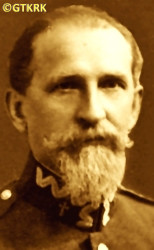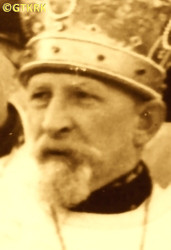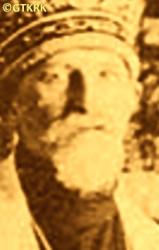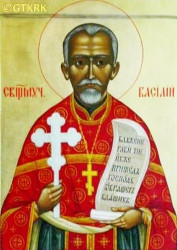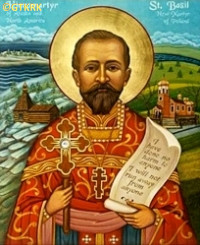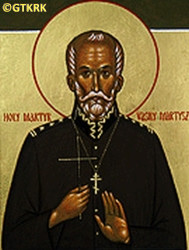Roman Catholic
St Sigismund parish
05-507 Słomczyn
85 Wiślana Str.
Konstancin deanery
Warsaw archdiocese, Poland
full list:
displayClick to display full list

searchClick to search full list by categories
wyświetlKliknij by wyświetlić pełną listę po polsku

szukajKliknij by przeszukać listę wg kategorii po polsku

Martyrology of the clergy — Poland
XX century (1914 – 1989)
personal data
religious status
saint
surname
MARTYSZ
forename(s)
Basil (pl. Bazyli)

canonisation date
07.06.2003

Saint Council of the Bishops of the Polish Autocephalous Orthodox Churchmore on
en.wikipedia.org
[access: 2019.12.07]
function
presbiter (i.e. iereus)
creed
Eastern Orthodox Church ORmore on
en.wikipedia.org
[access: 2014.09.21]
diocese / province
OR Military Ordinariate of Polandmore on
pl.wikipedia.org
[access: 2024.12.13]
honorary titles
„Polonia Restituta” Cross — 4th Class, Officer'smore on
en.wikipedia.org
[access: 2019.04.16]
(02.05.1923)
date and place
of death
04.05.1945

Teratyntoday: Uchanie gm., Hrubieszów pov., Lublin voiv., Poland
more on
en.wikipedia.org
[access: 2021.12.18]
details of death
During World War I, as a result of the Russian defeat by German and Austro–Hungarian troops in the Battle of Gorlice in 05.1915, evacuated with teacher of Realschule in Sosnowiec and millions of Russian officials, teachers, military personnel, etc., i.e. members of the Russian administration in Russian–occupied Poland, deep into Russia (so‐called bezhenstvo).
Settled at St Andronicus monastery in Moscow.
Next taught religion in Walday n. Moscow.
In 1917 after Bolshevik coup lost his job and had to undertake work at unloading train goods.
After the Bolshevik coup in Russia in 11.1917 and the separatist Bolshevik–German–Austrian treaty of 03.03.1918 in Brest–Litovsk, returned to Poland (perhaps it happened at the beginning of 1919, after Poland regained independence).
From 25.09.1919 chaplain of the Polish Army.
After retirement withdrew to Teratyn.
There after the end of the military conflict of the World War II, started by German and Russian invasion of Poland in 09.1939, after German defeat and start in 1945 of Russian occupation, murdered in unclear circumstances in his house in Teratyn. There are indications that the perpetrators were a unit of the National Armed Forces NSZ opposing the Russian occupation, but it originates from Russian sources, which undermines their credibility. It is also possible that became the victim of a bandit robbery attack. Finally, it is also possible that was murdered as one of the victims of «Genocidium Atrox» — the genocide of the Polish population committed by the Ukrainian genocidal OUN/UPA organization — murders that at that time were still carried out in the area of Hrubieszów, where resided.
cause of death
murder
perpetrators
Poles
sites and events
«Genocidium Atrox»Click to display the description, Ribbentrop‐MolotovClick to display the description
date and place
of birth
21.02.1874

Teratyntoday: Uchanie gm., Hrubieszów pov., Lublin voiv., Poland
more on
en.wikipedia.org
[access: 2021.12.18]
alt. dates and places
of birth
20.02.1874
parents
MARTYSZ Alexander
🞲 ?, ? — 🕆 ?, ?

KOROLCZUK Catherine
🞲 ?, ? — 🕆 ?, ?
presbyter (holy orders)
ordination
10.12.1900

positions held
31.05.1934 – 1945
retired (i.e. „at rest”) — Teratyntoday: Uchanie gm., Hrubieszów pov., Lublin voiv., Poland
more on
en.wikipedia.org
[access: 2021.12.18] — initially (c. 09.01.1925 to 1936) at the St Mary Magdalene Equal–to–the–Apostles in Warsaw–Prague
30.10.1919 – 31.05.1934
Chaplain in Chief — Warsawtoday: Warsaw city pov., Masovia voiv., Poland
more on
en.wikipedia.org
[access: 2021.10.09] ⋄ Office of Non–Catholic Denominations BWN, Main Military Orthodox Pastoral Office, Ministry of Military Affairs of Poland — formally: 01.08.1921‐01.06.1927 Department of Non–Catholic Denominations WWN in the Main Orthodox Military Pastoral Office of the Ministry of Military Affairs (from 05.1933 at the Minister of Military Affairs); from 1920 head of the Section of Non–Catholic Religions and Care of War Graves in the Main Orthodox Pastoral Office of the Ministry of Military Affairs; from 30.09.1919 head of the Religious and Denominational Section of the First Mobilization and Organizational Department of the Ministry of Military Affairs
16.06.1922
protopresbiter — Polish Autocephalous Orthodox Church PACP — dignity conferment
16.06.1922
mitred — Polish Autocephalous Orthodox Church PACP — dignity conferment, the right to wear the liturgical headgear in the form of a four–part closed crown with images of God, the Mother of God and some saints, decorated with precious stones
13.09.1921
OR military protopresbiter — Polish Armed Forces — promotion: commissioned, in the rank of the colonel
from 25.09.1919
OR military chaplain — Polish Armed Forces — commissioned, in 1921 verified with seniority from 01.06.1919, in the captain rank
c. 1919
parish priest — Sosnowiecform.: Sosnowice (till 1920)
today: Sosnowiec city pov., Silesia voiv., Poland
more on
en.wikipedia.org
[access: 2020.12.11] ⋄ St Vera, St Hope, St Luba and their mother St Sophie OR parish — appointed administrator of Orthodox churches in the Chełm region, but prob. did not take up the position
c. 1915 – c. 1918
teacher — Valdaytoday: Valday urban, Valday reg., Novgorod oblast, Russia
more on
en.wikipedia.org
[access: 2024.03.02] — prefect
1912 – 1915
prefect — Sosnowiecform.: Sosnowice (till 1920)
today: Sosnowiec city pov., Silesia voiv., Poland
more on
en.wikipedia.org
[access: 2020.12.11] ⋄ Realschule ⋄ St Vera, St Hope, St Luba and their mother St Sophie OR parish
c. 1912
dean — Western CanadaOrthodox deanery name
today: Czechia OR deanery
till c. 1912
priest — Stary Wostoktoday: St Michael, Lamont County r. mun., Central Alberta reg., Alberta prov., Canada
more on
en.wikipedia.org
[access: 2024.03.02] ⋄ Holy Trinity OR church
priest — Edmontontoday: Edmonton city reg., Alberta prov., Canada
more on
en.wikipedia.org
[access: 2022.11.20] ⋄ St Barbara OR church
priest — Troytoday: Troy, Rensselaer Cou., New York US‐NY state, United States of America
more on
en.wikipedia.org
[access: 2024.03.02] ⋄ St Nicholas OR parish
c. 1910
administrator — Waterburytoday: Naugatuck Valley, New Haven Cou., Connecticut US‐CT state, United States of America
more on
en.wikipedia.org
[access: 2024.03.02] ⋄ Nativity of the Blessed Virgin Mary OR parish
12.1907 – 02.1910
parish priest — Old Forgetoday: Old Forge, Lackawanna Cou., Pennsylvania US‐PA state, United States of America
more on
en.wikipedia.org
[access: 2024.03.02] ⋄ St Michael the Archangel OR parish
priest — Osceola Millstoday: Osceola Mills urban, Clearfield Cou., Pennsylvania US‐PA state, United States of America
more on
en.wikipedia.org
[access: 2024.03.02] ⋄ Nativity of the Blessed Virgin Mary OR parish
1900 – 1905
parish priest — Kodiaktoday: Kodiak Island Cou., Alaska US‐AK state, United States of America
more on
en.wikipedia.org
[access: 2024.03.02] ⋄ Our Lord's Resurrection OR parish — also: pastor of the surrounding towns and islands belonging to the Eparchy of the Aleutian Islands and North America (since 1903 the Vicariate Eparchy of Alaska within the Archeparchy of North America): the missionary facility and Nativity of the Theotokos chapel he founded on the island of Afognak, the islands of Spuce and Woody
10.12.1900
presbiter (Eng. priest, i.e. iereus) — Russian Orthodox Church — priesthood cheirotonia, i.e. ordination, on 06.12.1900 preceded by deacon cheirotonia
till c. 1900
teacher — Sosnowiecform.: Sosnowice (till 1920)
today: Sosnowiec city pov., Silesia voiv., Poland
more on
en.wikipedia.org
[access: 2020.12.11] — prefect
from 01.06.1898
psalmist — Łukówtoday: Łuków urban gm., Łuków pov., Lublin voiv., Poland
more on
en.wikipedia.org
[access: 2020.09.24] ⋄ St Nicholas the Wonderworker OR church — also: catechist
teacher — Suwałkitoday: Suwałki city pov., Podlaskie voiv., Poland
more on
en.wikipedia.org
[access: 2021.12.18] — prefect
till 1897
student — Chełmtoday: Chełm city pov., Lublin voiv., Poland
more on
en.wikipedia.org
[access: 2021.08.20] ⋄ philosophy and theology, Orthodox Theological Seminary
married — four children
others related
in death
BAZYLUKClick to display biography James (monk Ignatius), HOLCClick to display biography Nicholas, KOROBCZUKClick to display biography Leo, OHRYZKOClick to display biography Peter, PERADZEClick to display biography Gregory (Fr Gregory), SZWAJKOClick to display biography Paul, ZACHARCZUKClick to display biography Sergius
sites and events
descriptions
«Genocidium Atrox»: In 1939‐1947, especially in 1943‐1944, independent Ukrainian units, mainly belonging to genocidal Ukrainian organizations OUN (political arm) and UPA (military arm), supported by local Ukrainian population, murdered — often in extremely brutal way — in Volyn and surrounding regions of pre‐war Poland, from 130,000 to 180,000 Poles, all civilians: men, women, children, old and young. Polish‐Ukrainian conflict that openly emerged during and after World War I (in particular resulting in Polish‐Ukrainian war of 1918‐1919), that survived and even deepened later when western Ukraine became a part Poland, exploded again after the outbreak of the World War II in 09.1939. During Russian occupation of 1939‐1941, when hundreds of thousands of Poles were deported into central Russia, when tens of thousands were murdered (during so‐called Katyń massacres, among others), this open conflict had a limited character, helped by the fact that at that time Ukrainians, Ukrainian nationalists in particular, were also persecuted by the Russians. The worst came after German‐Russian war started on 22.06.1941 and German occupation resulted. Initially Ukrainians supported Germans (Ukrainian police was initiated, Ukrainians co—participated in extermination of the Jews and were joining army units fighting alongside Germans). Later when German ambivalent position towards Ukraine became apparent Ukrainians started acting independently. And in 1943 one of the units of aforementioned Ukrainian OUN/UPA organization, in Volyn, started and perpetrated a genocide of Polish population of this region. In mere few weeks OUN/UPA murdered, with Germans passively watching on the sidelines, more than 40,000 Poles. This strategy was consequently approved and adopted by all OUN/UPA organisations and similar genocides took place in Eastern Lesser Poland (part of Ukraine) where more than 20,000 Poles were slaughtered, meeting however with growing resistance from Polish population. Further west, in Chełm, Rzeszów, etc. regions this genocide turned into an extremely bloody conflict. In general genocide, perpetrated by Ukrainian nationalists, partly collaborating with German occupants, on vulnerable Polish population took part in hundreds of villages and small towns, where virtually all Polish inhabitants were wiped out. More than 200 priests, religious and nuns perished in this holocaust — known as «Genocidium Atrox» (Eng. „savage genocide”) The nature and purpose of genocide is perhaps best reflected in the song sung by the murderers: „We will slaughter the Poles, we will cut down the Jews, we must conquer the great Ukraine” (ukr. „Поляків виріжем, Євреїв видусим, велику Україну здобути мусим”). This holocaust and conflict ended up in total elimination of Polish population and Polish culture from Ukraine, in enforced deportations in 1944‐1945 of remaining Poles from Ukraine and some Ukrainians into Ukraine proper, and finally in deportation of Ukrainians from East‐South to the Western parts of Polish republic prl by Commie‐Nazi Russian controlled Polish security forces („Vistula Action”). (more on: www.swzygmunt.knc.plClick to attempt to display webpage
[access: 2021.06.20])
Ribbentrop‐Molotov: Genocidal Russian‐German alliance pact between Russian leader Joseph Stalin and German leader Adolf Hitler signed on 23.08.1939 in Moscow by respective foreign ministers, Mr. Vyacheslav Molotov for Russia and Joachim von Ribbentrop for Germany. The pact sanctioned and was the direct cause of joint Russian and German invasion of Poland and the outbreak of the World War II in 09.1939. In a political sense, the pact was an attempt to restore the status quo ante before 1914, with one exception, namely the „commercial” exchange of the so‐called „Kingdom of Poland”, which in 1914 was part of the Russian Empire, fore Eastern Galicia (today's western Ukraine), in 1914 belonging to the Austro‐Hungarian Empire. Galicia, including Lviv, was to be taken over by the Russians, the „Kingdom of Poland” — under the name of the General Governorate — Germany. The resultant „war was one of the greatest calamities and dramas of humanity in history, for two atheistic and anti‐Christian ideologies — national and international socialism — rejected God and His fifth Decalogue commandment: Thou shall not kill!” (Abp Stanislav Gądecki, 01.09.2019). The decisions taken — backed up by the betrayal of the formal allies of Poland, France and Germany, which on 12.09.1939, at a joint conference in Abbeville, decided not to provide aid to attacked Poland and not to take military action against Germany (a clear breach of treaty obligations with Poland) — were on 28.09.1939 slightly altered and made more precise when a treaty on „German‐Russian boundaries and friendship” was agreed by the same murderous signatories. One of its findings was establishment of spheres of influence in Central and Eastern Europe and in consequence IV partition of Poland. In one of its secret annexes agreed, that: „the Signatories will not tolerate on its respective territories any Polish propaganda that affects the territory of the other Side. On their respective territories they will suppress all such propaganda and inform each other of the measures taken to accomplish it”. The agreements resulted in a series of meeting between two genocidal organization representing both sides — German Gestapo and Russian NKVD when coordination of efforts to exterminate Polish intelligentsia and Polish leading classes (in Germany called «Intelligenzaktion», in Russia took the form of Katyń massacres) where discussed. Resulted in deaths of hundreds of thousands of Polish intelligentsia, including thousands of priests presented here, and tens of millions of ordinary people,. The results of this Russian‐German pact lasted till 1989 and are still in evidence even today. (more on: en.wikipedia.orgClick to attempt to display webpage
[access: 2015.09.30])
sources
personal:
lemko.orgClick to attempt to display webpage
[access: 2013.05.19], prasa.wiara.plClick to attempt to display webpage
[access: 2013.05.19], www.impantokratoros.grClick to attempt to display webpage
[access: 2020.09.24], pl.wikipedia.orgClick to attempt to display webpage
[access: 2013.05.19], www.impantokratoros.grClick to attempt to display webpage
[access: 2013.05.19], pl.wikipedia.orgClick to attempt to display webpage
[access: 2025.10.15]
bibliographical:
„Hierachy, clergy and employees of the Orthodox Church in the 19th‐21st centuries within the borders of the Second Polish Republic and post–war Poland”, Fr Gregory Sosna, M. Antonine Troc-Sosna, Warsaw–Bielsk Podlaski 2017
original images:
commons.wikimedia.orgClick to attempt to display webpage
[access: 2020.09.24], twitter.comClick to attempt to display webpage
[access: 2021.12.19], www.szkolawielgus.plClick to attempt to display webpage
[access: 2020.09.24], prawoslawie.plClick to attempt to display webpage
[access: 2020.09.24], orthpol.beClick to attempt to display webpage
[access: 2020.09.24], www.impantokratoros.grClick to attempt to display webpage
[access: 2020.09.24]
LETTER to CUSTODIAN/ADMINISTRATOR
If you have an Email client on your communicator/computer — such as Mozilla Thunderbird, Windows Mail or Microsoft Outlook, described at WikipediaPatrz:
en.wikipedia.org, among others — try the link below, please:
LETTER to CUSTODIAN/ADMINISTRATORClick and try to call your own Email client
If however you do not run such a client or the above link is not active please send an email to the Custodian/Administrator using your account — in your customary email/correspondence engine — at the following address:

giving the following as the subject:
MARTYROLOGY: MARTYSZ Basil
To return to the biography press below:
 Click to return to biography
Click to return to biography








